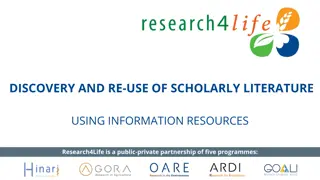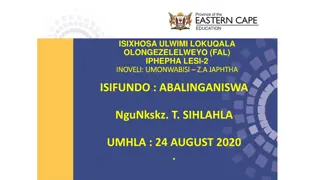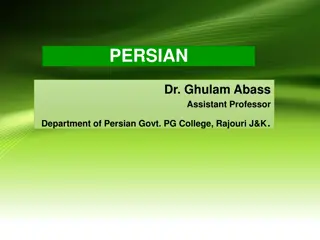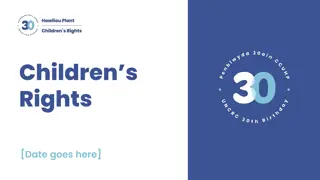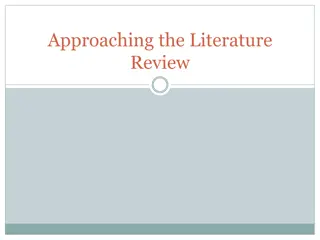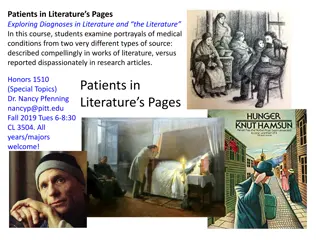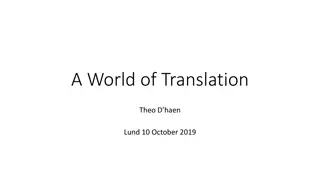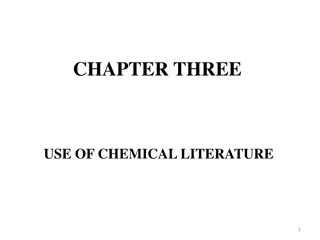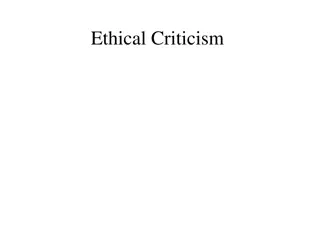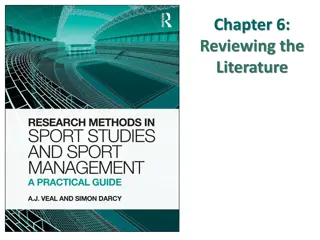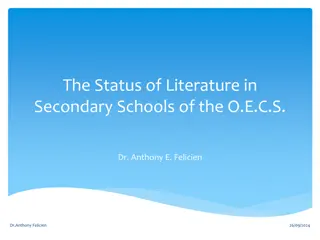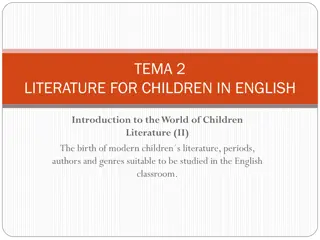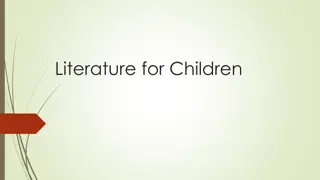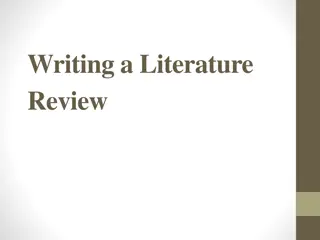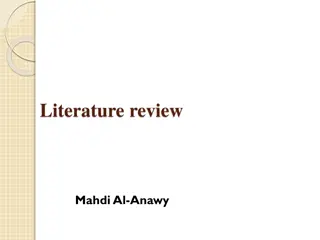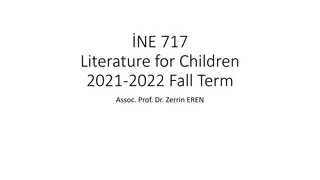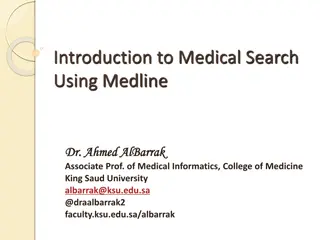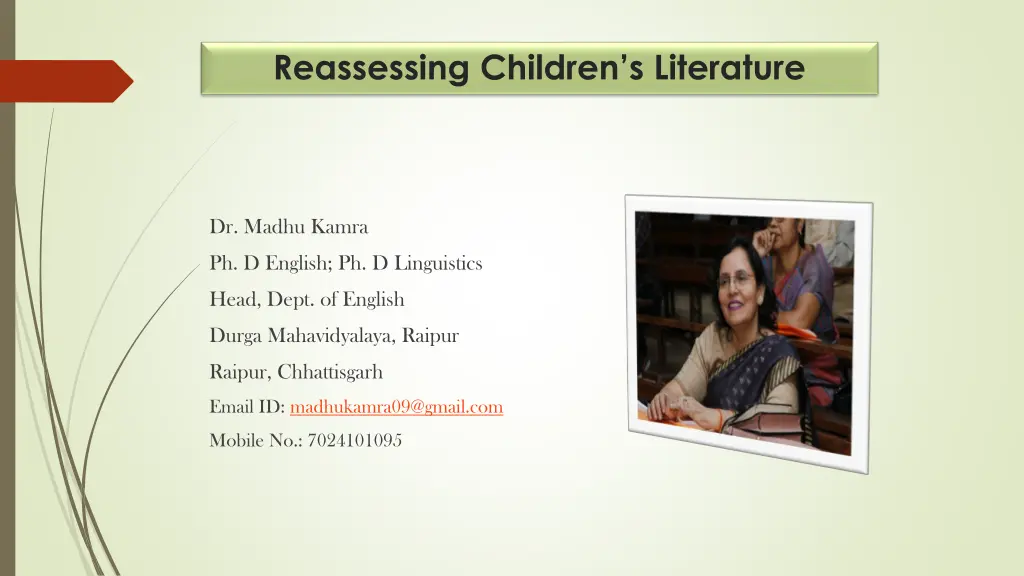
Insights into Children's Literature: Reassessing, Understanding, and Appreciating
Delve into the world of children's literature with Dr. Madhu Kamra as she explores the importance, neglect, physicality, materiality, and storytelling aspects of this genre. Discover how children's literature extends warmth and comfort, clarifies concepts, and shapes young minds. Uncover the historical neglect of children's literature and its evolution over time. Explore the physical and material elements that make children's books engaging and impactful. Gain insights into the types of stories that resonate with young readers, offering drama, emotion, and relatability. Immerse yourself in the world of children's literature and understand its significance in shaping young imaginations.
Download Presentation

Please find below an Image/Link to download the presentation.
The content on the website is provided AS IS for your information and personal use only. It may not be sold, licensed, or shared on other websites without obtaining consent from the author. If you encounter any issues during the download, it is possible that the publisher has removed the file from their server.
You are allowed to download the files provided on this website for personal or commercial use, subject to the condition that they are used lawfully. All files are the property of their respective owners.
The content on the website is provided AS IS for your information and personal use only. It may not be sold, licensed, or shared on other websites without obtaining consent from the author.
E N D
Presentation Transcript
Reassessing Childrens Literature Dr. Madhu Kamra Ph. D English; Ph. D Linguistics Head, Dept. of English Durga Mahavidyalaya, Raipur Raipur, Chhattisgarh Email ID: madhukamra09@gmail.com Mobile No.: 7024101095
Why Childrens Literature a. Extension of the warmth the comfort / the security they treasure. b. Makes two world concept clearer. c. Construct the world beyond home, housed by other children, adults, Vegetative and Animal Kingdom. d. Children are not born with good taste by birth, books do the required pruning.
Why Neglect of Childrens Literature 1. The conceptual framework of society which unrecognised Childhood . 2. Childhood was fragile due to high morality rate and poor life span. 3. Parenting was not an organised enterprises. 4. A Child s distinct needs were not identified and recognised. 5. Society s Vague conception about pedagogic vehicles 6. Children s Literature for a writer was not prestigious.
Why Neglect of Childrens Literature Children s Literature first has its birth in oral fairy lates to serve the Salon Culture. In the slow travel of hundred years from 17thto 19thCentury The Perrault s Coddling attitude to Grimm s reasoning attitude .
Physicality of Childrens Literature 1. Short Length for quick Reading 2. The structure for easy holding/ handling 3. Catchy Covers 4. Bold and Primary Colours 5. Bold letters 6. Interesting Motifs 7. Trendy Jackets 8. Sturdy Spine
Materiality and Texture 1. Adequate description 2. Concrete events 3. Emphatic action 4. Preponderance of Discourse 5. Limited Vocabulary 6. Narrow myths and mild pun
Materiality and Texture 7. Animals as supporters to the Protagonists 8. Avoidance of Excessive Emotion 9. Multifold and Manifold Horror 10. Affluence of Magic and Fantasy 11. A Rounded off story with end on - feel of Justice to Prevail Optimism
What kind of stories? 1. Stories should tell a tale. 2. Concur with the age, the interest, the mood and the environment of the readers. 3. Stories with drama makes things happens . 4. Stories are relative to their way of feeling, thinking, reaction and a place of experiences. Note Demands little explicit attention of the critics.
Texture of Childrens Literature 1. Shorts Sentences 2. Simple dialogue 3. Limited lexicon/ Genuine Vocab 4. Child s point of view 5. Minimal/ no embellishment to Circumstances.
Texture of Childrens Literature 6. According to Grimm in the later version this new concept of childhood is explained in the following three aspects a. The relations in the family Circle b. The innocence of the Child c. The need for instruction of the Child
Dormant state of Childrens Literature 1. Children s literature analysis requires interdisciplinary approach and activity. 2. At the beginning the focus was primarily on plot character and settling and theme as stubbornly conservative approach. 3. Teaching of Children s Literature is the University of Global stand is short in History of 35 Years. 4. In India, Children s Literature is still waiting at the threshold academia to be awarded a specific academic unit. 5. Children s Literature insisted on the usefulness of reading to establish connection between pleasure and reflection. Children are imaginative and creatives Adults are rational creatures Indicates a cross fertilized approach
Paradox of Childrens Literature 1. The voice and point of view of an adult author is inadequate. 2. Is the author sharing the experience of being a child. 3. Children s literature is not owned by children. 4. Callousness to George Mac Donald s cry do not write for Children, but for the childlike, Whether of five or fifty or Seventy - five. (A Dish of orts London: Sampson law, 1985) 5. Children s literature is the only literature defined by its addresses. 6. Perry Nodelman raises a need for a space necessarily separate from the world of adults .
How do Children respond? The greater the involvement, the stronger is happiness binding due to gratification. Benton and Fox elaborated how the reader creates a secondary world. The reading experience is characterised in 2 ways- a. A four phase process of feeling like: 1. a. Reading b. Getting into story c. Being lost in the book d. An increasing sense of ending 2. On activity consisting of four elements: a. Picturing b. Anticipating and Restrospecting c. Interacting d. Evaluating
How Does Childrens Respond? N. Tucker observed that children emphasizes on the Quality of the writing as opposed to the Pace of the plot . During the primary phase Acquiescent reading style is noticeable inclusive of (RAPS) responding aloud protocols like- 1. Paraphrasing 2. Thematising 3. Allegorising 4. Problem Solving
Modes of Story Telling Andrea Schwenke Wyile s (1999- 2003) accounts of three types of narration Children s Literature Immediate Distant Engaging Distancing Narration
What sells? 1. Best sellers are high or domestic fantasy. 2. Fantasy is unhindered vista by realistic constraints. 3. For adults, the secondary world of Fantasy provide the adult with a utopian unknown universe. 4. Commodification of the child s innocence to a child reader. It encapsulates the essence of innocent living, but for an adult, it is nostalgic and voyeuristic need.
New Steps 1. Peter Hunt pioneers the childist criticism, which propounds that the child is not a mere paper being devoid of all power in the world of Children s books. 2. Children s literature is now considered a legitimate field of academic research. 3. Assertion of the concept that children s literature is an important vehicle for achieving required aims of healthy education. 4. No longer occupies an inferior status within the literary polysystem. 5. Cultural institutions, Curriculum and National libraries as well as to Encyclopedia are now open to receive CL.
Purpose and Policy Dormant sexuality in the west. Assertion of Racism. Projecting social misfits as real life people. Nasty instances: 1. Lewis carroll known for inventing Alice s Adventures in Wonderland whose criminal intent resulted in taking nude photographs of little girls. 2. William Mayne, popular British author of The Chair School Series (1955 1963) was put behind bass for assaulting several minor girls of his fandom. Ambiguous state between Romantic or Sentimental Portrayal of childhood.
Purpose and Policy Attempts to extricate children s Literature from the narrow boundaries to place it in the foreground of literary scholarship. Attempts to check polarization.
What are Picture Books and Why 1) They are Signs Something [which] stands to somebody for something else in some respect or capacity (Umberto Eco). 2) As iconic signs they resemble what they depict to see the actual in terms of fictional visualization of it. 3) They purport to show us what the words tell . 4) They are easy and smooth ways to integrate children into the ideology of our culture. 5) Trains young minds to mumble What do you mean?
What are Picture Books and Why 7) Pictures need to have ideal optical for consistency. 8) Pictures capture Decisive moments which lessing calls as Privileged moment and picture has more of Material limits . 9) Locus of gaze is more defined and detailed.
Popular Stories 1. Cinderella 2. Snow White 3. Rumpelstiltskin
Theorist- Mitzi Myers Mitzi Myers was a formative scholar who revived wee wee stories and contributed richly to Encyclopaedia American and to the Cambridge companion. To her books were her biological children. Culturing The Child 1690 1914 (2005) (Author: Danelle Ruwe) hints at agencies in children s lives. Core themes are family, friends, neighbourhood, animal and vegetative kingdom along with airy World to contextualize agency in the cultures and voices of the future adults she had an extensive library for children s book and was an extremely rigorous scholars. She worked with Zest and no sleep for Kids turned into sophisticated consumers .
Maria Nikolajeva Aesthetic approaches to children s Literature: An Introduction by Maria Niko LAJEVA . As the title indicates, this is a marked approach to children s Literature. The tool kit it suggests explores the aesthetics of content, Scene, Composition , Character, Narration and the like. A Professor of Comparative Literature at Stockholm University (Sweden), has authored books of immense analytical depth like: The Rhetoric of Children s Literature, 2002 and From Myths to Linear Time in Children s Literature 2000.
Carolyn Steedman She says The interiorised self understand to be the product of a personal history was most clearly expressed in the idea of childhood; and the idea of the child . The seem of technical knowledge about childhood increased dramatically in the middle years of the 19thcentury, and there was a Veritable explosion of information about the period of physiology and cognitive development in human being. A child is often reminded of its littleness to the visceral sense of smallness of the self that lies inside then A child is associated with emotional tawdriness. The develop of the self is not new but rather then location of the self that is new .
Cinderella: Projects how collaborative efforts can heal a fractured society Mitzi Myers- Points out Children s literature suffer from something like the critical equivalent of urban blight (1986:31). (Cinderella aided autonomy by the animal world devised) Cinderella projects a masculine's tradition of children s literature Cinderella. Children s literature is the most conservative and conceptually orthodox as a genre in its approach and effect to mobilise young readers to assimilate the dominant literary codes of the culture.
Explore Zohar Shavit Children s Literature constitute one of Althusser s Ideological State Apparatuses (see ideology). The literary polysystem contains as Shavit notes both canonical and non canonical books. Children read their Literature through books and films and shop windows and Magazines and Video games . Here, culture and Market place are connected.
Reading reading of Childrens Literature 1. Children s literature is both a wonder drug and a making mould . 2. Labelled as Therapeutic by Butler (Cushla and her Books) who argues picture books are instrumental handicapped child . In a broader Bibliotherapy . in the sense rehabilitation children s of a multiple aid literature to 3. A deep impact story is mere of a Intervention programme. 4. Bibliotherapy helps child be a ludic reader (coinage by Victor Nell). So that he can construct his inner newsreel and be conscious of his inner responses. 5. Bibliotherapy helps children to regulate his inchoate. 6. Personally preferred Texts can regulate further reading.
Uses of Childrens Literature a. Different opinion exist relating what is children s literature for? b. A Chambers in The Reading Environment: How Adult Help children Enjoy Books says Story telling is indispensable in enabling people to become literary readers . c. Jack Zipes a distinguished American Expert on children s literature writes- If storytelling are to be effective on behalf of children in schools. It is important to try to instil a sense of community, self reflecting and self critical community in the children to demonstrate how the ordinary can become extraordinary. (1995: 6).
Uses of Childrens Literature d. Children s book are of world and one of the features of critical theory which has made it unattractive to many children s book practitioners. e. A storybook is required to condition the nature of understanding that the little reader has constructed through interaction and experience. f. Children s literature trains a growing mind in the complexities of meaning.
To Read More Tucker N. Ed. Approaches to Research in Children s Literature Southampton University 1980. Stephens. J. Language and Ideology in Children s Fiction. London: Longman, 1992. Hunt, Peter. Ed. Understanding Children s Literature. London: Routledge, 1999. Wall, Barbara, The Narrator s Voice: The Dilemma of Children s Fiction Basing stoke, Macmillan, 1991.

